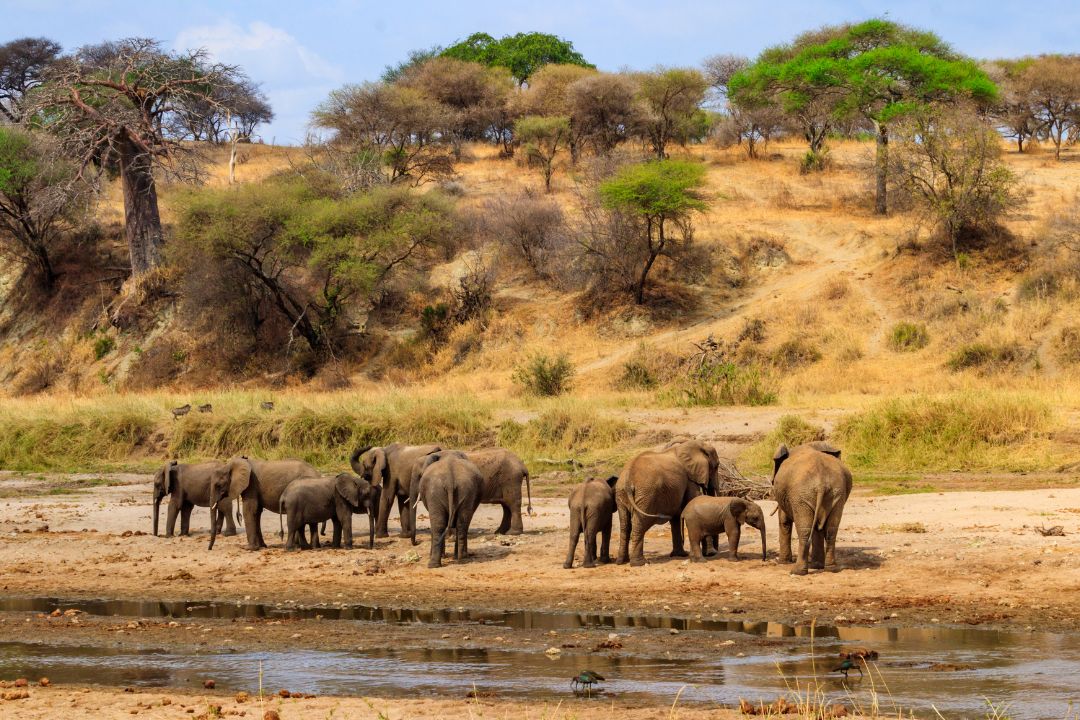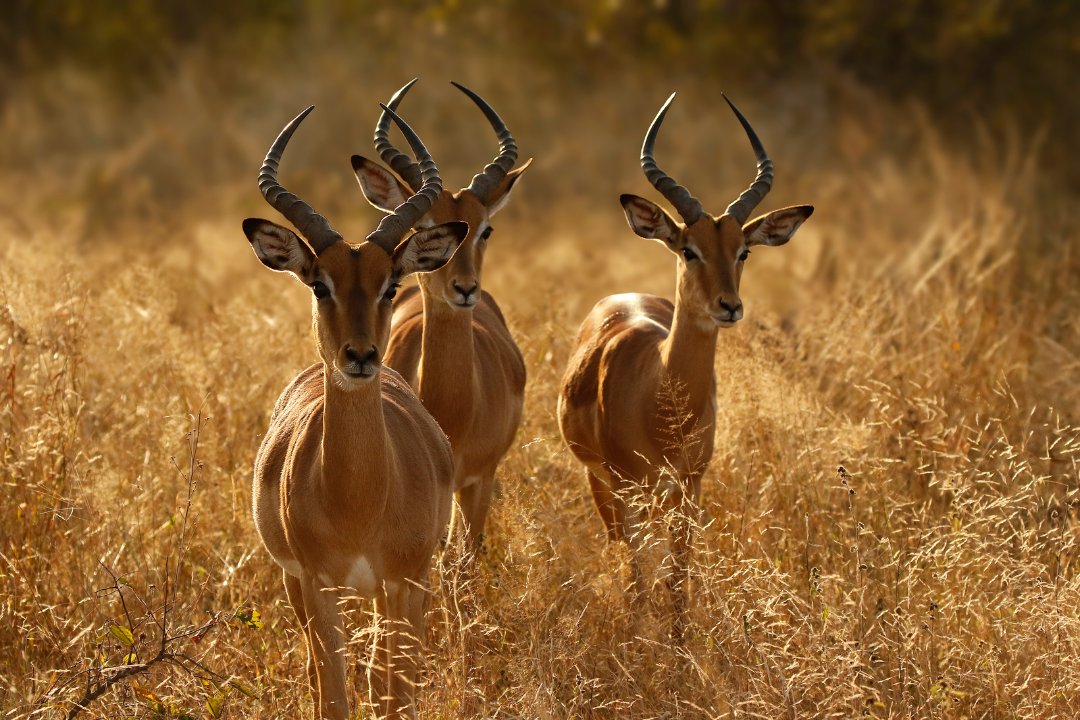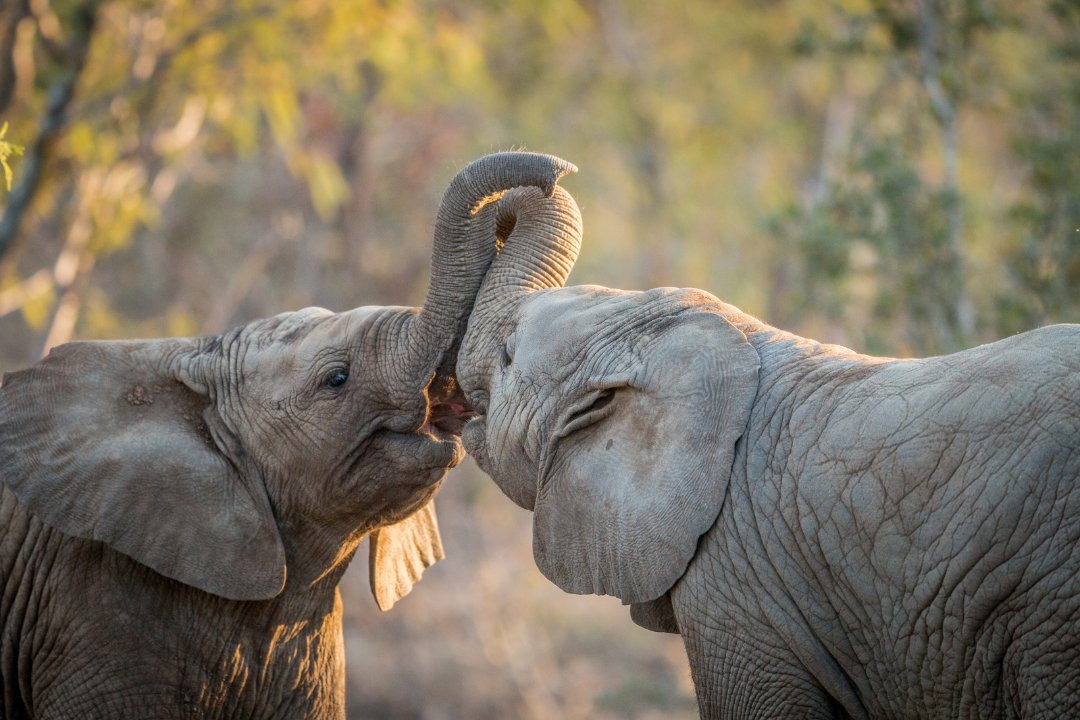Tarangire National Park, located in northern Tanzania, is a captivating wildlife sanctuary known for its vast elephant herds and unique baobab tree-dotted landscape. Covering approximately 2,850 square kilometers, Tarangire is the sixth largest national park in Tanzania. The park derives its name from the Tarangire River, which runs through the heart of the park and provides a vital water source for wildlife, especially during the dry season. This river attracts a plethora of animals, making the park a prime spot for game viewing. The diverse habitats, ranging from swamps and wetlands to acacia woodlands and savannah, support a rich variety of flora and fauna, offering visitors an immersive experience in one of Africa’s less-crowded yet incredibly scenic parks.
One of the most distinctive features of Tarangire National Park is its impressive population of elephants. Known for having one of the highest concentrations of elephants in Tanzania, the park provides ample opportunities for close-up encounters with these majestic creatures. Additionally, Tarangire is home to a wide array of wildlife, including lions, leopards, cheetahs, buffalo, giraffes, and numerous bird species, with over 550 species recorded. The park is also famous for its ancient baobab trees, some of which are over a thousand years old, and its termite mounds that dot the landscape. Tarangire’s unique blend of abundant wildlife, striking landscapes, and relative tranquility makes it a must-visit destination for nature enthusiasts and those seeking an authentic safari experience in Tanzania.



1. What is the best time to visit Tarangire National Park? The best time to visit Tarangire National Park is during the dry season, from June to October, when wildlife is more concentrated around the Tarangire River and other water sources. The wet season, from November to May, is also a good time to visit for bird watching and lush landscapes, though animal sightings can be more dispersed.
2. How do I get to Tarangire National Park? Tarangire National Park is accessible by road and air. It is about a 2-hour drive from Arusha, the main gateway for northern Tanzania safaris. There are also scheduled and charter flights from Arusha and other major airports to airstrips within or near the park.
3. What accommodation options are available in Tarangire National Park? The park offers a variety of accommodation options, including luxury lodges, tented camps, and budget campsites. Many lodges and camps are located within the park, offering convenient access to game viewing, while others are situated just outside the park boundaries.
4. Is it safe to visit Tarangire National Park? Yes, it is generally safe to visit Tarangire National Park. However, visitors should always follow the guidance of experienced guides and adhere to park rules and regulations. It’s also important to take health precautions such as vaccinations and malaria prophylaxis.
5. What wildlife can I expect to see in Tarangire National Park? Tarangire is renowned for its large elephant herds and is home to a diverse range of wildlife, including lions, leopards, cheetahs, buffalo, giraffes, zebras, wildebeest, and numerous antelope species. The park also hosts over 550 bird species, making it a birdwatcher’s paradise.
6. Do I need a visa to visit Tarangire National Park? Yes, most visitors will need a visa to enter Tanzania. Visas can be obtained upon arrival at the airport or in advance from Tanzanian embassies and consulates. It is advisable to check the latest visa requirements before you travel.
7. What should I pack for a trip to Tarangire National Park? Pack light, breathable clothing in neutral colors, a wide-brimmed hat, sunglasses, sunscreen, and insect repellent. Binoculars and a good camera are essential for wildlife viewing. Sturdy walking shoes and a warm jacket for early morning and evening game drives are also recommended.
8. Are there any cultural experiences available near Tarangire National Park? Yes, visitors can explore cultural experiences with the Maasai people who live near the park. Many tours offer visits to Maasai villages where you can learn about their traditions, see traditional dances, and purchase handmade crafts.
9. What activities are available in Tarangire National Park? Activities in Tarangire National Park include game drives, guided walking safaris, bird watching, and night game drives. Some lodges also offer cultural visits to nearby Maasai villages and hot air balloon safaris.
10. How does Tarangire National Park contribute to conservation? Tarangire plays a significant role in conservation by protecting diverse species and habitats. The park is involved in various initiatives to combat poaching, preserve endangered species, and promote sustainable tourism. Conservation fees paid by visitors support these efforts and help maintain the park’s ecological balance
For questions or booking inquiries, call +255 672 827 822 or
contact us.
What people say about Tarangire National Park in Tripadvisor
 Bean G2024-07-20Memorable Safari Experience with Wild Rhythm Adventure Our 5-day safari with Wild Rhythm Adventure, led by Ian, was simply incredible. Ian's expertise and passion for wildlife made every moment unforgettable. From thrilling game drives to stunning sunsets, it was a journey of a lifetime.I highly recommend Wild Rhythm Adventure to anyone seeking an authentic safari experience. Their professionalism, dedication, and passion for wildlife conservation make them a standout choice for exploring the wonders of Africa. Thank you, Ian and the team, for an unforgettable journey!
Bean G2024-07-20Memorable Safari Experience with Wild Rhythm Adventure Our 5-day safari with Wild Rhythm Adventure, led by Ian, was simply incredible. Ian's expertise and passion for wildlife made every moment unforgettable. From thrilling game drives to stunning sunsets, it was a journey of a lifetime.I highly recommend Wild Rhythm Adventure to anyone seeking an authentic safari experience. Their professionalism, dedication, and passion for wildlife conservation make them a standout choice for exploring the wonders of Africa. Thank you, Ian and the team, for an unforgettable journey! softwareman p2024-07-10Marangu route with Wild Rhytm I recently completed the Marangu route on Mount Kilimanjaro with Wild Rhythm Adventures. The experience was exceptional, thanks to the expertise and dedication of our guide, Johnson. The organization and support provided by Wild Rhythm Adventures ensured a safe and memorable trek. Johnson's knowledge of the terrain, coupled with his encouraging demeanor, made the challenging journey enjoyable. I highly recommend Wild Rhythm Adventures for anyone looking to conquer Kilimanjaro.
softwareman p2024-07-10Marangu route with Wild Rhytm I recently completed the Marangu route on Mount Kilimanjaro with Wild Rhythm Adventures. The experience was exceptional, thanks to the expertise and dedication of our guide, Johnson. The organization and support provided by Wild Rhythm Adventures ensured a safe and memorable trek. Johnson's knowledge of the terrain, coupled with his encouraging demeanor, made the challenging journey enjoyable. I highly recommend Wild Rhythm Adventures for anyone looking to conquer Kilimanjaro. Геннадия Р2024-07-09Truly Unforgettable Adventure Wild Rhythm Adventures provided an exceptional 2-day safari experience that exceeded all expectations. From the moment we departed, every detail was meticulously arranged, ensuring seamless transitions between parks and maximizing our time with wildlife. Lake Manyara National Park showcased its famed tree-climbing lions and diverse birdlife, while Tarangire National Park offered unforgettable encounters with elephants and stunning baobab trees. The knowledgeable guides made each game drive informative and exciting, enhancing our understanding of the ecosystem. Accommodations were comfortable, meals delicious, and the overall service impeccable. A truly unforgettable adventure, highly recommended for anyone seeking a glimpse into Tanzania's natural wonders.
Геннадия Р2024-07-09Truly Unforgettable Adventure Wild Rhythm Adventures provided an exceptional 2-day safari experience that exceeded all expectations. From the moment we departed, every detail was meticulously arranged, ensuring seamless transitions between parks and maximizing our time with wildlife. Lake Manyara National Park showcased its famed tree-climbing lions and diverse birdlife, while Tarangire National Park offered unforgettable encounters with elephants and stunning baobab trees. The knowledgeable guides made each game drive informative and exciting, enhancing our understanding of the ecosystem. Accommodations were comfortable, meals delicious, and the overall service impeccable. A truly unforgettable adventure, highly recommended for anyone seeking a glimpse into Tanzania's natural wonders. naomie m2024-06-07Amazing A serious agency, i highly recommend. During these 3 days in Tanzania, Hammad listened to our needs and expectations, we were able to discover wonderful places. Thank you again for the professionalism of the agency!
naomie m2024-06-07Amazing A serious agency, i highly recommend. During these 3 days in Tanzania, Hammad listened to our needs and expectations, we were able to discover wonderful places. Thank you again for the professionalism of the agency! Abeid J2024-05-31incroyable experience We traveled with Wild Rhythm Adventures, and it was wonderful! Our guide, Hussein, was excellent—highly knowledgeable about Tanzania, adept at locating wildlife, efficient on the roads, and fluent in French. Our accommodations were amazing, and the itinerary was perfect. We highly recommend Wild Rhythm Adventures!
Abeid J2024-05-31incroyable experience We traveled with Wild Rhythm Adventures, and it was wonderful! Our guide, Hussein, was excellent—highly knowledgeable about Tanzania, adept at locating wildlife, efficient on the roads, and fluent in French. Our accommodations were amazing, and the itinerary was perfect. We highly recommend Wild Rhythm Adventures! jesca m2024-05-31*Exceptional Safari Experience with Wild Rhythm Adventures* Last year, I had the pleasure of experiencing a two-day safari in Tanzania with Wild Rhythm Adventures, exploring the incredible Tarangire and Ngorongoro. It was an unforgettable adventure. The safari was meticulously organized, and every detail was taken care of, ensuring a seamless and enjoyable experience. Our guide Hasheem, was knowledgeable, friendly, and passionate about the wildlife and the environment. They took us to some of the most stunning spots, where we witnessed an incredible array of animals and breathtaking landscapes. Wild Rhythm Adventures provided excellent service from start to finish. The accommodations were comfortable and well-chosen, adding to the overall enjoyment of the trip. I highly recommend Wild Rhythm Adventures for anyone looking to explore the beauty of Tanzania through a well-curated safari experience. Their professionalism and dedication to creating memorable adventures truly set them apart. Thank you, Wild Rhythm Adventures, for an amazing journey!
jesca m2024-05-31*Exceptional Safari Experience with Wild Rhythm Adventures* Last year, I had the pleasure of experiencing a two-day safari in Tanzania with Wild Rhythm Adventures, exploring the incredible Tarangire and Ngorongoro. It was an unforgettable adventure. The safari was meticulously organized, and every detail was taken care of, ensuring a seamless and enjoyable experience. Our guide Hasheem, was knowledgeable, friendly, and passionate about the wildlife and the environment. They took us to some of the most stunning spots, where we witnessed an incredible array of animals and breathtaking landscapes. Wild Rhythm Adventures provided excellent service from start to finish. The accommodations were comfortable and well-chosen, adding to the overall enjoyment of the trip. I highly recommend Wild Rhythm Adventures for anyone looking to explore the beauty of Tanzania through a well-curated safari experience. Their professionalism and dedication to creating memorable adventures truly set them apart. Thank you, Wild Rhythm Adventures, for an amazing journey! Albright N2024-05-30Unforgettable Safari Experience with Wild Rhythm Adventures My name is Jimmy, and last year I had the privilege of embarking on a 5-day safari in Tanzania with Wild Rhythm Adventures. Our journey took us through the breathtaking landscapes of Tarangire, Ngorongoro, and the Serengeti, and it was truly a journey of a lifetime. Our guide, Ian, was exceptional. He was not only extremely knowledgeable about the wildlife and environment but also a genuinely nice and personable guy. Ian showed us an incredible array of animals and provided deep insights into the diverse ecosystems we explored. His enthusiasm and expertise made our experience all the more memorable and enjoyable. Wild Rhythm Adventures provided us with outstanding service. The entire team was highly professional, organized, and attentive to every detail. Their dedication to ensuring a seamless and unforgettable experience was evident throughout our trip. We felt safe, well-cared-for, and thoroughly enjoyed every moment. I highly recommend Wild Rhythm Adventures to anyone seeking an extraordinary safari experience in Tanzania. Their expertise, dedication, and warm hospitality set them apart. If you're planning a safari, look no further than Wild Rhythm Adventures! Thank you, Wild Rhythm, for an amazing adventureShowing our latest reviews
Albright N2024-05-30Unforgettable Safari Experience with Wild Rhythm Adventures My name is Jimmy, and last year I had the privilege of embarking on a 5-day safari in Tanzania with Wild Rhythm Adventures. Our journey took us through the breathtaking landscapes of Tarangire, Ngorongoro, and the Serengeti, and it was truly a journey of a lifetime. Our guide, Ian, was exceptional. He was not only extremely knowledgeable about the wildlife and environment but also a genuinely nice and personable guy. Ian showed us an incredible array of animals and provided deep insights into the diverse ecosystems we explored. His enthusiasm and expertise made our experience all the more memorable and enjoyable. Wild Rhythm Adventures provided us with outstanding service. The entire team was highly professional, organized, and attentive to every detail. Their dedication to ensuring a seamless and unforgettable experience was evident throughout our trip. We felt safe, well-cared-for, and thoroughly enjoyed every moment. I highly recommend Wild Rhythm Adventures to anyone seeking an extraordinary safari experience in Tanzania. Their expertise, dedication, and warm hospitality set them apart. If you're planning a safari, look no further than Wild Rhythm Adventures! Thank you, Wild Rhythm, for an amazing adventureShowing our latest reviews